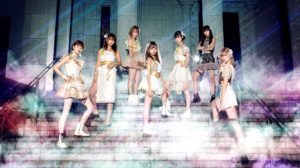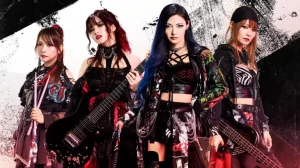Ultimate J-Pop Vocab Guide: The Idol Dictionary
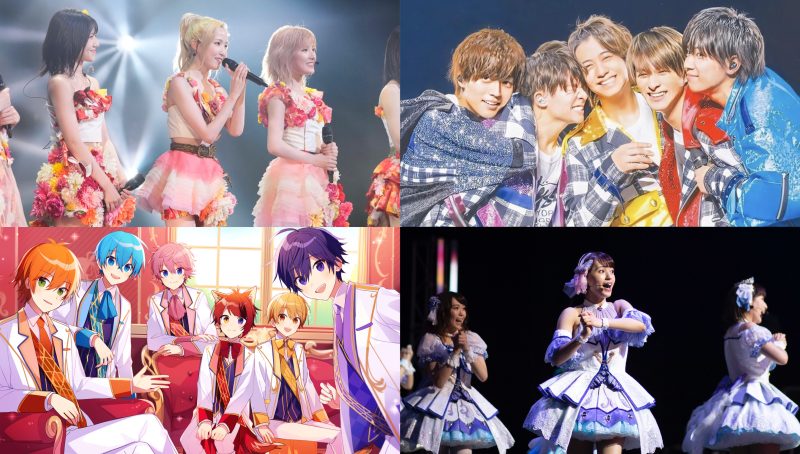
Are you interested in J-Pop and Japanese idols but unsure where to start? This is a complete dictionary for all the unfamiliar terms you might encounter, types of idols, unique genres, idols you should know, and more! Japan has a diverse and thriving music industry and is one of the largest music markets worldwide; since there’s so much ground to cover, this guide will specifically focus on the Japanese idol industry and culture.
Idol (アイドル, aidoru): A type of performer characterized by their skill in singing and dancing and the support they receive from a dedicated fanbase. Idols may be known not only for their skills, but for their appearance and personality. Oftentimes, idols also act, model, write songs, choreograph dances, and/or are ambassadors for cities/brands. The idol industry originated in Japan in the 1960’s, but has since inspired similar industries in South Korea, China, Thailand, and more.
Section 1 – Standard Vocabulary:
- Ace (エース, ēsu):
- 1. A group’s center.
- Ex. 1. Atsuko Maeda was the ace of AKB48 until her graduation; she was the center for 22 A-sides and 19 B-sides.
See also: Center - 2. A multi-talented idol who excels above the rest; a groups “most valuable player.”
- Ex. 2. Many fans call Shunsuke Michieda the ace of Naniwa Danshi for his skills in singing, dancing, acting, modeling, attractive appearance, and popularity.
- Akiba-kei (秋葉系): Lit. “Akihabara style.” Akihabara is a district in Tokyo considered a “haven” of otaku culture, with dozens of stores dedicated to anime, manga, video games, maid cafés, and more. Akiba-kei idols are idols that represent this culture.
Ex. Dempagumi.inc, a girl group whose members are all otaku, is a popular example of Akiba-kei idols. - Boy Group (ボーイズグループ, bōizu gurupu): A music unit with all male members who do not perform with instruments. Can apply to idol groups, dance & vocal groups, DJ groups, etc.
Ex. Boy groups include Bullet Train, BALLISTIK BOYZ, and 8LOOM.- Boy Band (ボーイバンド, bōi bando): A boy group whose members perform with instruments.
- Call (コール, kōru): Cheers shouted by the audience during performances. Also called “fan chants.” Sometimes created by fans, sometimes created by the idols or their agency. Usually, appropriate calls depend on who the performer is. Common ones include;
- “Ohhh!” (オーッ!)
- “Hai!” (はい!)
- “Yes! Tiger!” (イエッ!タイガ!)
- “Urya! Oi!” (うりゃ!おい!) (Part of the crowd shouts “Urya!” and the rest respond with “Oi!”)
- Individual members’ names or nicknames
- Certain lyrics
- Mix (ミックス, mikkusu): Specific fan chants cheered before songs or during instrumental breaks. There are many, but common ones include;
Standard Mix (Used before a song starts/during the first instrumental break): Ah, let’s go (yossha ikuzo)! Tiger! Fire! Cyber! Fiber! Diver! Viber! Jaa jaa!!” (あ~よっしゃ 行くぞ!タイガー!ファイヤー!サイバー!ファイバー!ダイバー!バイバー!ジャージャー!)
Japanese Mix (Used during the second instrumental break): Ah, let’s go again (mou iccho ikuzo)! Tora! Hi! Jinzou! Seni! Ama! Shindou! Kasen! Tobi! Joukyo! (あ~もう いっちょ 行くぞ!トラ!ヒ!ジンゾウ!センイ!アマ!シンドウ!カセン!トビ!ジョキョ!)
Ainu Mix (Less common; used if there’s a third instrumental break): Chape! Ape! Kara! Kina! Rara! Tusuke! Myohontusuke! (チャペ!アペ!カラ!キナ!ララ!トゥスケ!ミョーホントゥスケ!) - And more
Ex. Girl group CANDY TUNE showing the calls for their song “CuCuCuCute”.
- Call and Response (コールアンドレスポンス, kōru ando resuponsu): When a performer calls out to the audience and the audience responds, typically in a greeting, introduction, or catchphrase. Can be as simple as the standard “How are you doing tonight?”
Ex. Former HKT48‘s Sakura Miyawaki‘s catchphrase involved audience response;
Sakura: “You too, you too, you too, in everyone’s heart…” (あなたも、あなたも、みんなの心に…)
Crowd: “Sakura bloom!” (さくら咲けー!)
Sakura: “I’m Sakura Miyawaki, _ years old, from Kagoshima Prefecture!” (鹿児島県出身、宮脇咲良_歳です!) - Center (センター, sentā): An idol chosen to stand in the middle of their group during performances. The center tends to be the most popular and/or most talented member and is someone who represents the group as a whole. The role of center can vary from song to song or be a fixed position depending on the group.
Ex. Since she was chosen to be the center of ≠ME for her vocal skills, Nanaka Tomita always stands in the middle of the group’s performances and supports her teammates from there. - Chika (地下, chika): “Underground.” In this context, it generally refers to chika idols (see next section).
- CM: A commercial.
Ex. In 2014, Morning Musume starred alongside the comedy unit Morisanchuu in a CM for the mobile phone company au, with their song “Password is 0” as the theme. Watch here. - Dance & Vocal Group (ダンス&ボーカルグループ, dansu & bokaru gurūpu): A group whose members sing and dance, but do not label themselves as idols. Typically, members of these groups train for longer than idols, more focus is on their talent and less on their personalities, and the group has a more mature concept.
Ex. Popular dance & vocal groups include GENERATIONS from EXILE TRIBE, Atarashii Gakkou!, and XG.- In some cases, the line between idol groups and dance & vocal groups can be pretty thin. There is no exclusive criteria besides what the group refers to themselves as.
- Dance Leader (ダンスリーダー, dansu rīdā): A position in some idol groups. A distinct role from the leader. The dance leader is a member who is both skilled in dance and is an effective leader to their teammates, guiding and giving them advice when needed.
Ex. Ai Kiyama is the dance leader of BATTEN GIRLS. - DD: Stands for “daremo daisuki” (誰も大好き), which means “I love anyone.” Someone who likes every member of a group and has no oshimen/ichiban.
Ex. “I’m a DD because I don’t have a favorite member of BE:FIRST.”- Note: There is no final answer for the difference between DD and MD. Different sources give different answers. However, DD has a more negative connotation than MD.
- Fan Name (ファンネーム, fan nēmu): A unique name for a group or an idol’s fans. Also called “fandom name” (ファンダムネーム, fandamu nēmu). May be official or unofficial.
Ex. BABYMETAL’s official fan name is “THE ONE,” but individual fans often call themselves “kitsunes.” - Fan Service (ファンサービス, fansābisu): When idols intentionally behave in a way to entertain or gratify fans, such as flirting with fans, member ai, acting excessively cutesy, and similar. Called “Fansa” (ファンサ) for short.
Ex. “Do you think she flirted with me because she liked me, or was it just fan service?”- Aikyō (愛嬌): “Charm” or “loveable quality.” Direct translation of Korean’s “aegyo” (애교); intentionally behaving cutely. However, this term is not often used to describe Japanese idols’ cute behavior.
- See also: Member Ai
- Girl Group (ガールズグループ, gāruzu gurupu): A music unit with all female members who do not perform with instruments. Can apply to idol groups, dance & vocal groups, DJ groups, etc.
Ex. Girl groups include =LOVE, Perfume, and PRIKIL.- Girls Band (ガールズバンド, garuzu bando): A girl group who performs with instruments.
- Generation (期, -ki): In groups which use the graduation system, all members are categorized in generations based on when they entered the group.
Ex. Nana Yamada, as one of the founding members of NMB48, was a 1st generation member; her younger sister, Suzu Yamada, who joined six years later, was a 5th generation member. - Graduation (卒業, sotsugyou): When an idol departs a group. Almost all groups, even those that don’t use the graduation system, use this term for departures.
Ex. After being a member of Momoiro Clover Z since 2009, Momoka Ariyasu graduated in 2018 to live a more normal life. She is now a singer and a photographer.- Graduation System: A rotational system where, as idols grow out of their group, decide on a new path in life, or similar, they will graduate from the group and new members are introduced to take their place. This way, groups can last indefinitely. Pioneered by Onyanko Club and popularized by Morning Musume.
- Gravure (グラビア, gurabia): A type of provocative photography or pin-up modeling; models are posed and dressed suggestively, but the content is not outright pornographic and is meant to be more playful and innocent than ordinary glamour photography. It’s fairly common for Japanese idols, especially female idols, to do gravure.
Ex. In August 2023, Nogizaka46‘s Mayu Tamura released her first photobook “Koi ni Ochita Shunkan” containing both ordinary photos and gravure shoots. - Hafu (ハーフ, haafu): Biracial; typically describes someone who is half-Japanese.
Ex. Nina, the youngest member of NiziU, is a hafu; she has an American father and a Japanese mother.- Note: Hafu may be controversial in some contexts. Some biracial Japanese prefer the synonymous term “double” (ダブル, daburu). It depends on the individual.

A member of Kamen Joshi crowdsurfing on an inflatable raft
- Handshake Event (握手会, akushukai): Event where fans who purchased a ticket can meet an idol and shake hands with them. Fans are given a time limit, but until then they can chat with their favorite idol and sometimes get a two-shot with them. However, different idol groups will have different rules for how much and what kind of contact idols and fans can have at these events.
Ex. “I had to wait in line for a while at the handshake event, but I finally got to meet my oshi! A staff member took a cheki of us, and she signed it.”- Two-shot (ツーショット, tsū shotto): A photo of a fan and an idol.
- Cheki (チェキ): A Polaroid photo.
- Fanmi (ファンミ): Fan meeting; an event where idols and fans can meet and interact. Handshake events are a type of fan meeting. However, the phrase “fanmi” is mostly used by Japanese fans of K-Pop idols, not fans of J-Pop idols. It’s not a common phrase for the latter.
- Note: Tickets typically come with purchases of photobooks and albums. The more tickets you have, the more time you have to interact with your favorite idol.
- Ichiban (一番 ): Lit. “Number one” or “best.” Describes a fan’s favorite member, or bias, in a male group.
Ex. “Kaito Takahashi is my King & Prince ichiban because he’s the cutest.”- Niban (二番): Lit. “Number two” or “second.” Describes a fan’s second favorite member in a male group.
- Sanban (三番): Lit. “Number three” or “third.” Describes a fan’s third favorite member in a male group.
- See also: Oshimen
- Note: Some male groups also use “oshimen“/”oshi.”
- Ikemen (イケメン): A good-looking man.
Ex. “Junki from JO1 is a total ikemen! He’s so handsome, he caught my eye immediately.” - Indie Debut (インディーズ, indīzu): When idols first release music on an independent label. Oftentimes, idols will release music independently at first, and make their major debut (see below) on a big label later on.
Ex. WATWING made their indie debut with HoriPro in 2019 and their major debut with TOY’S FACTORY in 2021. - Josei Area (女性エリア, josei eria): Lit. “Female area.” A special area of the audience reserved for female fans at some venues. This can be useful since male fans at idol events have a reputation for poor behavior and hygiene.
- Kakkoii (格好いい/かっこいい): “Cool” or “good-looking.”
Ex. TWICEのジョンヨンは大変カッコイイですね。(TWICE no Jeongyeon wa taihen kakkoii desu ne.)
“TWICE‘S Jeongyeon is very cool (kakkoii), isn’t she?” - Kamitaiou (神対応, kami taiō): Lit. “Godly interaction.” When an idol is kind and sincere to a fan.
Ex. “My oshi remembered my name and chatted with me! That was a godly interaction (kamitaiou)!”
See also: Shiotaiou - Kawaii (可愛い/かわいい): “Cute,” “pretty,” and/or “loveable.” Used both as an adjective to describe something cute and as a noun to mean the concept or culture of cuteness.
Ex 1. TWICEのモモはほんとうにかわいいですね。(TWICE no Momo wa hontō ni kawaii desu ne.)
“TWICE‘s Momo is really cute (kawaii), isn’t she?” - Kenshuusei (研修生, kenshūsei): Trainee; a person training to become an idol.
Ex. Kaito Miyachika was a kenshuusei for twelve years before debuting with Travis Japan.- Some groups may use “kenkyuusei” (研究生, kenkyūsei, lit. “research student”) instead.
- Leader (リーダー, rīdā): A member who represents the group as a whole; typically the oldest or one of the oldest members, or the member with the most experience. Leaders are generally a member who is experienced, responsible, and authoritative. Their duties may include interacting with staff and the producer, helping to organize events, mediating disagreements between members, and giving them encouragment and advice.
Ex. The leader of GENIC is Maiki Nishimoto..- Co-leader (副リーダー, fuku rīdā): Similar duties to the leader; the second-in-command. Also called “sub-leader.”
Ex. The co-leader of PRIKIL is Rin. - Some groups use “Captain” (キャプテン, kyaputen) and “Co-captain” (副キャプテン, fuku kyaputen) instead.
- Note: Not all groups have an official leader, and leader duties depend on the groups themselves. Some leaders are figureheads, while others are active in the group’s management.
- Co-leader (副リーダー, fuku rīdā): Similar duties to the leader; the second-in-command. Also called “sub-leader.”
- LINE (ライン, lain): The most popular social network in Japan. Offers free messaging, voice chat, video calling, and more. Known for the cute stickers offered in-app. Also offers related apps such as LINE Pay, LINE Games, LINE News, LINE Doctor, LINE Music, and more.
Ex. “Have you checked LINE? I sent you a message a few hours ago.“ - Live (ライブ, raibu): Concerts/shows. Short for “live concert” (ライブ・コンサート, raibu konsāto) or “live show” (ライブショー , raibu shō).
Ex. ATARASHII GAKKO! held their first arena live on October 29, 2023. - Live House (ライブハウス, raibu hausu): A type of small live music venue popular in Japan. All types of musicians – rock bands, jazz musicians, solo vocalists, and idols – especially chika idols – perform at these.
Ex. “My favorite idols are performing at this live house on Tuesday night! Do you want to come watch with me?“ - Love Ban (恋愛禁止, renai kinshi): A rule enforced by some talent agencies banning idols from romantic relationships.
Ex. After a dating scandal where photos of her with a man were leaked online, Mao Iguchi graduated from Hinatazaka46 for violating the love ban. - Major Debut (メジャーデビュー, mejā debyū): When idols first release music on a major label, such as Avex Inc., Universal Music Japan, TOY’S FACTORY, Sony Music Entertainment, NIPPON COLUMBIA, etc. Oftentimes, idols will release music independently at first (see indie debut) and make their major debut on a big label later on.
Ex. WATWING made their indie debut with HoriPro in 2019 and their major debut with TOY’S FACTORY in 2021. - MD: Stands for “minna daisuki” (みんな 大好き) which means “I love everyone.” Someone who likes every member of a group and has no oshimen/ichiban.
Ex. “I’m a MD because I love every member of BE:FIRST equally.”- Note: There is no final answer for the difference between DD and MD. Different sources give different answers. However, MD has a more positive connotation than DD.
- Member Ai (メンバー愛, menbā ai): Lit. “Member love.” A type of fan service – specifically, when idols act exceptionally loving towards their groupmate/s, e.g. flirting with them, touching or kissing them, and similar. Called “mem ai” or “men ai” (メン愛) for short.”
Ex. Boy group MeseMoa. went semi-viral for their member ai in the “Shadow Kiss” music video, where the idols made out on camera.
See also: Fan Service - Member Color (メンバーカラー, menbā karā): A color dedicated to each individual member of an idol group has. Typically, their costumes, merch, penlights, posters, etc. will be in this color. Not all, but most idol groups have these.
Ex. In SixTONES, Jesse‘s member color is red; Taiga‘s is pink; Hokuto‘s is black; Yugo‘s is yellow; Shintaro‘s is green; and Juri‘s is blue. - niconico (ニコニコ, nikoniko): A popular Japanese video sharing platform. Used in particular by utaites, odorites, etc. Formerly known as Nico Nico Douga (ニコニコ動画, Niko Niko Dōga).
Ex. Popular singer Ado began her career by posting covers on niconico.
A productive rehearsal with Travis Japan - Odorite (踊り手): People who dance to songs and upload it online, typically on niconico. These videos are called “odottemita” (踊ってみた, lit. “tried to dance.”) Some idols have their beginnings as odorites and/or post odottemitas as a hobby.
Ex. Kozue Aikawa began her dance career in 2008 as an odorite, usually posting odottemitas of VOCALOID songs. - One-man Live (ワンマンライブ, wan man raibu): A live with only one group performing; a solo concert.
Ex. Shortly after their debut in May, MAZZEL held their first one-man live on June 1, 2023 at LINE CUBE SHIBUYA. - OP: The opening theme song of a TV show.
Ex. Girl group Wasuta performed two of the OPs for the anime Idol Time PriPara.- ED: The ending theme song of a TV show.
- Oricon Chart (オリコンチャート, Orikon Chāto): A ranking of music sales in Japan issued by Oricon Inc. Also called the Oricon Ranking (オリコンランキング, Orikon Rankingu). There is a separate chart for albums and singles. Physical sales, digital sales, and streaming are counted. Charts are published on Oricon’s official website every Tuesday.
Ex. Technopop girl group Perfume‘s compilation album Perfume the Best “P Cubed” debuted at number one on the Oricon Chart and charted for 39 weeks. - Oshimen (推しメン): From the word “oshi” (推, meaning “support”) and “menba” (メンバ, meaning “member”). Describes a fan’s favorite member, or bias. Generally only used for female groups. Often shorted to just “oshi” (推し).
Ex 1. “My Cho Tokimeki♡Sendenbu oshimen is Julia because she’s the cutest!”
Ex 2. “I’m a Julia-oshi because she’s the cutest member!”- Oshihen (推し変): From “oshi” and “hen” (変, meaning “to change.”) To change your oshi from one member to another.
- Oshi-kaburi (推し被り): People who have the same oshi.
- Hako-oshi (箱推し): Lit. “Box favorite.” A fan who supports everyone in a group and doesn’t have an oshi.
- Kami-oshi (神推し): Lit. “God favorite.” A fan’s ultimate favorite or ultimate bias.
- Ni-oshi (二推し): A fan’s second favorite member.
- San-oshi (三推し): A fan’s third favorite member.
- Tan-oshi (単推し): Lit. “Single favorite.” A fan who only supports a singular member.
- Otaku (オタク): Geek; nerd; enthusiast. Typically describes enthusiasts of anime, manga, video games, etc., but can be any enthusiast, including idol fans. Also spelled “Wotaku” (ヲタク).
See also: Wota
Ex. “My friend is such an idol otaku; she owns dozens of albums and merchandise.“
- Penlight (ペンライト, penraito): Penlight; lightstick; a colorful glowing stick fans bring to concerts to support their favorite groups. Some groups/members have a certain color/s for their fans to bring to cheer them on.
Ex. “Moe Kamikokuryo‘s member color is aqua blue, so I bought an aqua blue penlight for ANGERME‘s concert.”- Cyalume (サイリウム, sairiumu): Cyalume is a specific brand of lightstick, although lightsticks in general may be called cyalumes.
- Pinchike (ピンチケ): Lit. “pink ticket.” A new fan who behaves poorly or disrespectfully while supporting a group. Typically used to refer to people at live events, but can refer to people online.
Ex. “That pinchike won’t stop screaming during the performance to get the idol to look at him… I just want to hear the music.”- Origin: At the AKB48 theatre, pink tickets were sold at a discounted price to students in middle and high school. These younger fans gained a reputation for immature behavior at concerts.
- Producer ( プロデューサー , puroduusaa): The person who produces an idol group; producers hold auditions, scout for talents, select which candidates will debut, decide how the idols are presented (what sets them apart, what their concepts are, etc.), what the goals the group has, how they’re marketed to consumers, plan and arrange events, produce/compose/write songs for the group, and more.
Ex. Famous producers include;- Yasushi Akimoto (Onyanko Club, Musukko Club, Checkicco, 22/7, THE COINLOCKERS, Last Idol, WHITE SCORPION, AKB48, SKE48, NMB48, HKT48, NGT48, STU48, JKT48, AKB48 Team TP, MNL48, BNK48, SDN48, Nogizaka46, Sakurazaka46, Hinatazaka46, Yoshimotozaka46, Boku ga Mitekatta Aozora)
- Tsunku (Morning Musume, ANGERME, Juice=Juice, Tsubaki Factory, BEYOOOOONDS, OCHA NORMA, °C-ute, Berryz Kobo)
- Johnny Kitagawa † (All Johnny’s & Associates Groups until 2019)
- Rino Sashihara (=LOVE, ≠ME, ≒JOY)
- Seitansai (聖誕祭, seitan sai): Lit. “holy birthday.” In the context of idols, it describes a special performance or concert done for an idol’s birthday.
Ex. For Suzuka Nakamoto’s 16th birthday, the concert LEGEND “1997” SU-METAL Seitansai was held at Makuhari Messe on December 21st, 2013. - Shiotaiou (塩対応): Lit. “Salty interaction.” When an idol is cold and uninterested to a fan. Usually an undesirable thing, but some fans enjoy being treated harshly and some idols make it their charm.
Ex. “It was a salty interaction (shiotaiou). My oshi barely said a word and ignored me most of the time.”
See also: Kamitaiou - Sister Group (姉妹グループ, shimai gurupu): Related groups that are marketed together; they are typically produced by the same person, managed by the same agency, and/or given a similar concept. The popularity of the older sister groups helps draw attention to newly-debuted little sister groups, and the little sister groups often perform covers of their seniors’ songs.
- Older Sister Group (姉分グループ, ane-bun gurupu): The senior group; the group which debuted first.
Ex. Momoiro Clover Z debuted in 2008 and is the older sister group of Shiritsu Ebisu Chuugaku. - Little Sister Group (妹分グループ, imouto-bun gurupu): The group which debuted after.
Ex. Shiritsu Ebisu Chuugaku debuted in 2009 and is the little sister group of Momoiro Clover Z.
- Older Sister Group (姉分グループ, ane-bun gurupu): The senior group; the group which debuted first.
- SNS: Social networking service. Websites like Instagram, Twitter, LINE, YouTube, etc.
Ex. “They posted a video of their dance practice on SNS, did you see?“ - Uchiwa (うちわ): A round fan; fans often bring uchiwas with messages or idols’ faces on them to concerts.
Ex. OCTPATH‘s official store sells uchiwas with the members’ faces on it to bring to events. - Utaite (歌い手): People who sing covers of songs and post them online, typically on niconico. These covers are called “utattemita” (歌ってみた, lit. “tried to sing.”) Some idols and singers began as utaites and/or post utattemitas as a hobby.
Ex. The duo ClariS began when the members began posting utattemitas on niconico in junior high as a utaite duo. - VOCALOID (ボーカロイド, bōkaroido): A voice synthesis software which replicates human vocals. Different voices, provided by different singers, are created into voice banks, with a unique character designed to represent the voice. These representative characters are also called VOCALOIDs.
Ex. Virtual singer Hatsune Miku is a VOCALOID released in 2007 whose voice bank was provided by Saki Fujita.- Note: While VOCALOID is the most famous voice synthesizing software, there are similar programs such as CevioAI, SynthV, UTAU and more.
- Wota (ヲタ): Abbreviation of “wotaku” (ヲタク). Someone who is a fan of idols.
Ex 1. “Sakurazaka46 is having a handshake event today, so wota have been in line since dawn.”
Ex 2. “She discovered Hey! Say! JUMP in 2012 and has been a Johnny’s wota ever since.”- Dolwota (ドルオタ, doruwota): An abbreviation of “idol wotaku” (アイドルヲタク, aidoru wotaku). Less commonly used.
- Dolwota (ドルオタ, doruwota): An abbreviation of “idol wotaku” (アイドルヲタク, aidoru wotaku). Less commonly used.
- Wotagei (ヲタ芸 ): An abbreviation of “Wotaku no gei” (ヲタクの芸), lit. “art of the wotaku.” Specific dances done by fans (or wotas) during idol concerts or events, composed of simple choreography, cheering, synchronized penlight movements, and claps.
Ex. Wotagei choreography for AKB48‘s GIVE ME FIVE! by 【ヲタ芸】白狐-Hako-
See also: Calls/Mix - Yonton (ヨントン): From the Korean word “영상통화” (yeongsangtonghwa) or “영통” (yeongtong) meaning “video call.” A video call between idols and fans. This is beginning to gain traction with Japanese idols in part due to the influence of K-Pop idols. Also called “fan calls.”
Ex. To promote their debut EP, &TEAM held a raffle where the winners could participate in a fan call (yonton) with the members. - Zaitaku (在宅): Lit. “At home.” Idol fans who never attend concerts or events due to distance, money, time, etc., but are fans from afar.
Ex. “I love INI, but I can’t afford to go to any of their concerts so I’m a zaitaku.“

Akiba-kei idols Dempagumi.inc
Section 2 – Types of J-Idols:
Alternative Idols (オルタナティブアイドル, orutanatibu aidoru): Idols who primarily perform other genres than pop, such as rock, metal, or hip-hop. Examples include BiS, ZOC, and BABYMETAL.
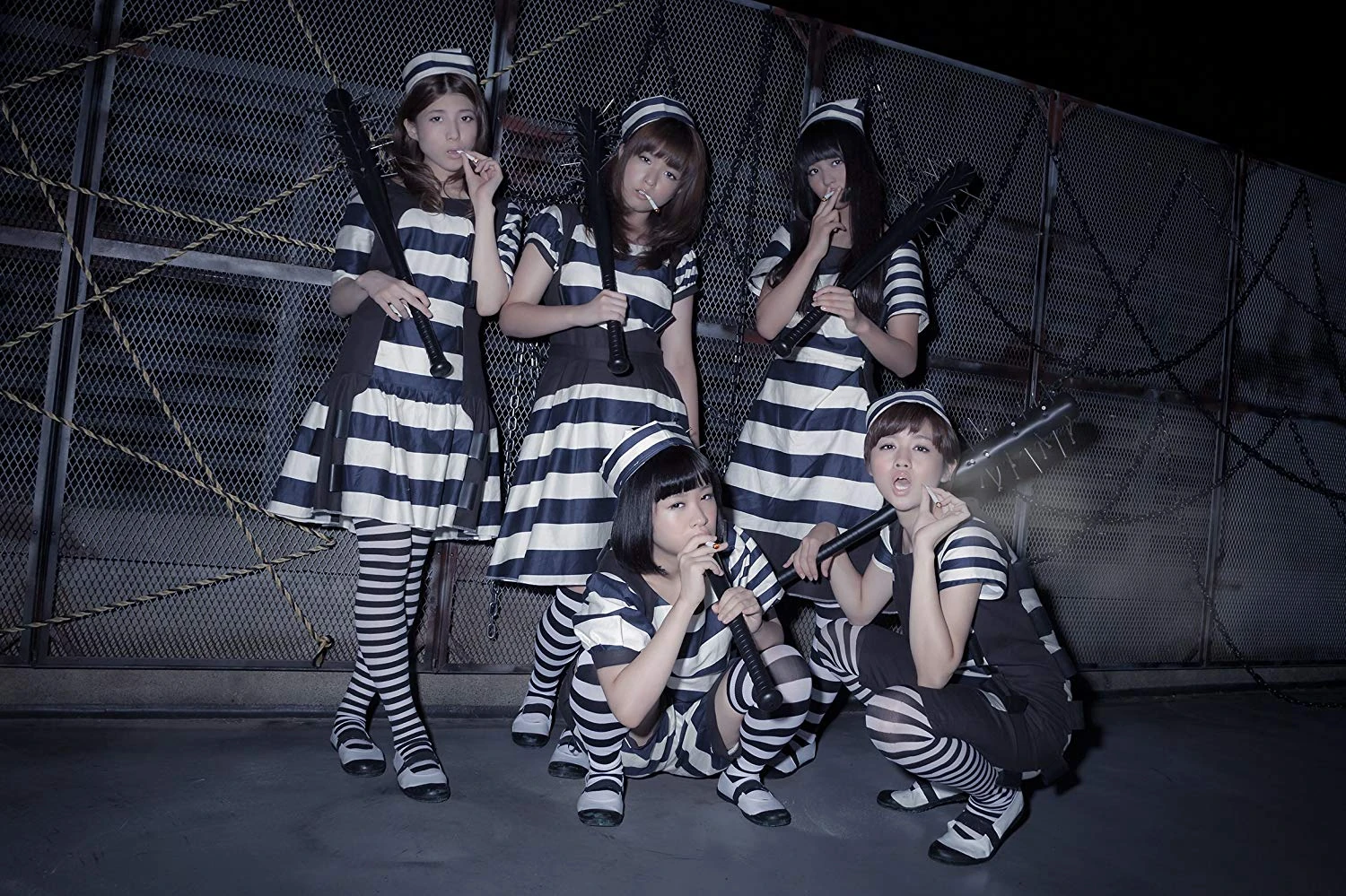 Featured: BiS
Featured: BiS
AV Idols (エーブアイドル): Adult video idols; pornographic actresses who also perform as idols. Examples include BRW108, Ebisu Muscats, and SEXY-J.

Featured: BLACK DIAMOND, a girl group composed of AV actresses.
Bandols (バンドル, bandoru): Combination of the words “band” and “idol.” Refers both to idols who play instruments like bands such as ZONE, Band Ja Naimon! MAXX NAKAYOSHI, and DISH//, or idol-like bands such as SILENT SIREN and Ganbare! Victory. Featured: SILENT SIREN
Featured: SILENT SIREN
Chika Idols (地下アイドル, chika aidoru): Underground idols. Idols who focus on small-scale live performances and events instead of mass-media exposure. Typically managed by small agencies or independent. Some dream of a big break, while others are content as they are. Also called live idols (ライブアイドル, raibu aidoru), indie idols (インディーズアイドル, indīzu aidoru), pre-idols (プレアイドル, pure aidoru) and real idols (リアル系アイドル, riaru-kei aidoru). Examples include Bunny La Crew, Tenshitsukinuke-ni-yomi, and Stellight.
Menchika (メン地下): Male underground idols.
Panchika (半地下): Semi-underground idols. Refers to idols who have made a major debut, but are not well-known. Examples include Pimm’s, Yandoll and ukka.
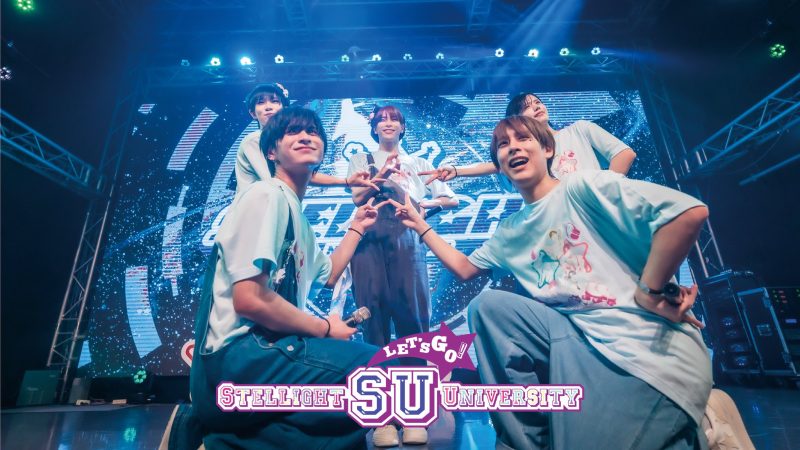 Featured: Stellight
Featured: Stellight
Dansei Idols (男性アイドル, dansei aidoru): Male idols.
Gravure Idols (グラビアアイドル, gurabia aidoru): Idols or talents who regularly do gravure modeling. Called “gradols” (グラドル, guradoru) for short. Examples include Hinako Sano, Aika Sawaguchi, and Yuno Ohara.
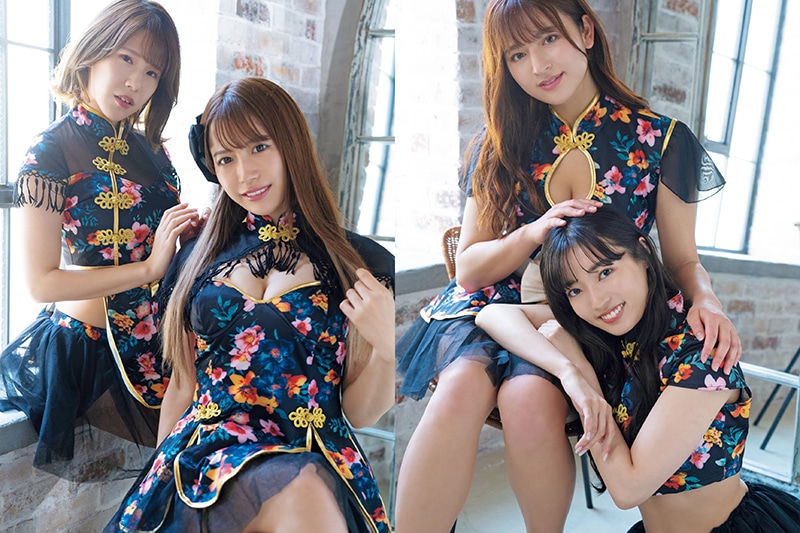
Featured: Chameleon Republic, an idol group composed of four gravure idols.
Josei Idols (女性アイドル, josei aidoru): Female idols.
Junior Idols (ジュニアアイドル, junia aidoru): Idols aged 15 or younger. Sometimes called “chidols” (チャイドル, chaidoru), short for “child idols,” although this term is mostly used for idols aged 12 or younger. Examples include Sakura Gakuin, Boys Be, and Ciào Smiles.
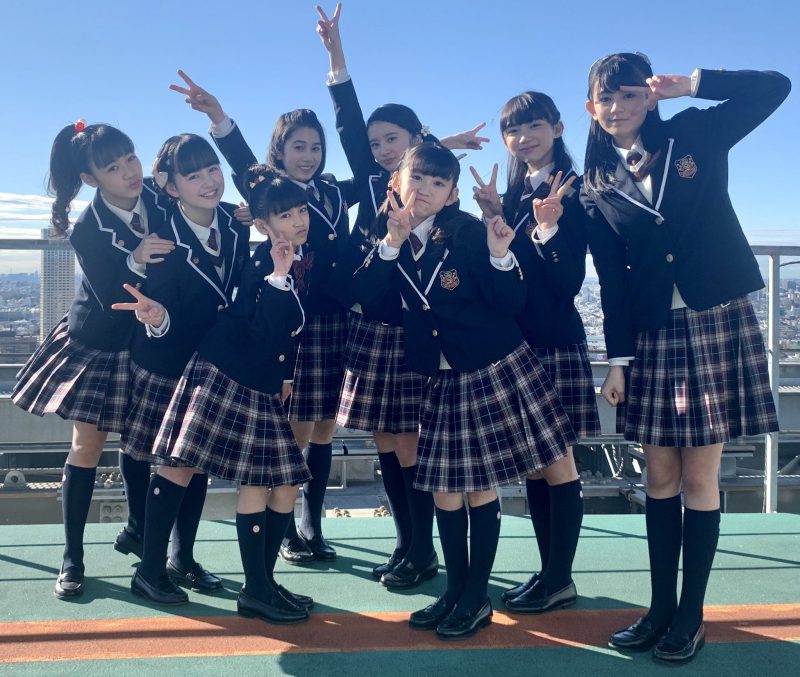
Featured: Sakura Gakuin 2020 Nendo
Kaigai Idols (海外アイドル, kaigai aidoru): Overseas idols, or foreign idols. Examples include PAiDA, Non Sweet, and Lulu Bitto.
What is a Kaigai Idol?: An Introduction and Guide to the Overseas J-Pop Community
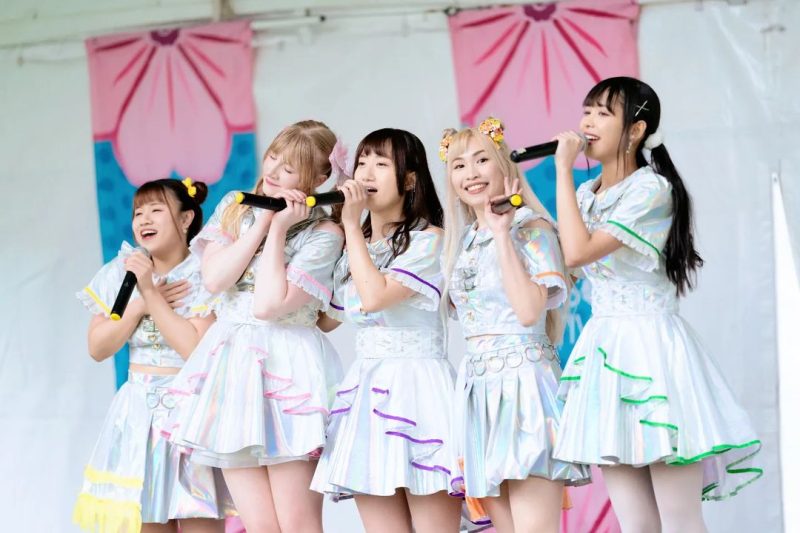
Featured: Non Sweet
Local Idols (ローカルアイドル, lokaru aidoru): Idols based in a specific region who promote said region. They appear at local events, draw visitors to their region, and build relationships with their local community. Also called “locodol” (ロコドル) for short, “gotōchi idols” (ご当地アイドル) or “regional (chihō) idols” (地方アイドル). Examples include Ringo Musume (based in Aomori), Vienolossi (Toyama), and Menkoi Girls (Gunma).
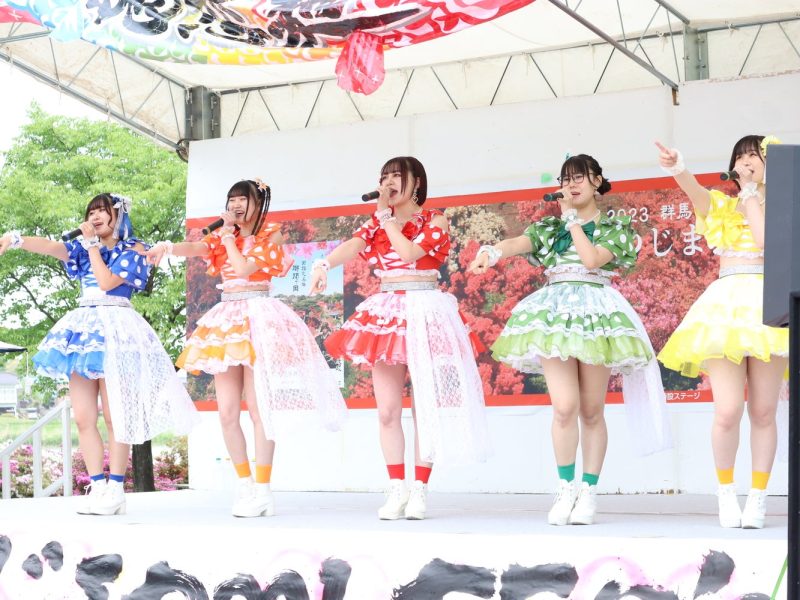
Featured: Menkoi Girls
National Idols (国民的アイドル, kokuminteki aidoru): Popular idols and idol groups known and loved by everyone in the nation. Examples include SMAP, AKB48, and Arashi.
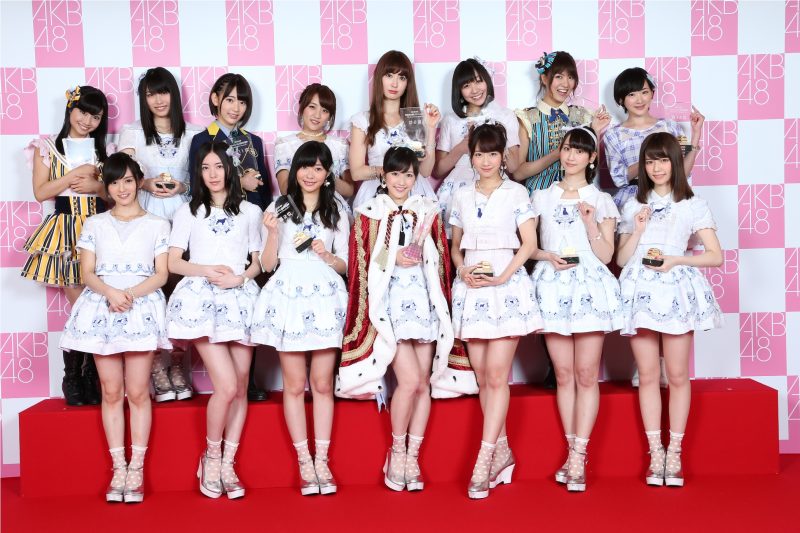 Featured: The top winners of AKB48‘s 2014 Senbatsu election – i.e. the most popular members at the time.
Featured: The top winners of AKB48‘s 2014 Senbatsu election – i.e. the most popular members at the time.
Top Row (Left to Right): Aya Shibata, Yui Yokoyama, Sakura Miyawaki, Minami Takahashi, Haruna Kojima, Akari Suda, Sae Miyazawa, Rina Ikoma
Bottom Row (Left to Right): Sayaka Yamamoto, Jurina Matsui, Rino Sashihara, Mayu Watanabe, Yuki Kashiwagi, Rena Matsui, Haruka Shimazaki
Net Idols (ネットアイドル, netto aidoru): Idols who mainly promote and conduct activities online instead of in-person. Examples include MICHIKO, Beckii Cruel, and DANCEROID.

Featured: DANCEROID, a girl group composed of net idols who posted on niconico. Active from 2009-2014.
Orthodox Idols (正統派アイドル, seitōha aidoru): Conventional idols. The idols you think of when someone mentions idols; classically cute girls with frilly stage costumes and bright smiles who perform fun pop music. Also called “royal idols” (王道アイドル, ōdō aidoru) although the exact definition of that term varies. Examples include FRUITS ZIPPER, Cho Tokimeki♡Sendenbu, and =LOVE.
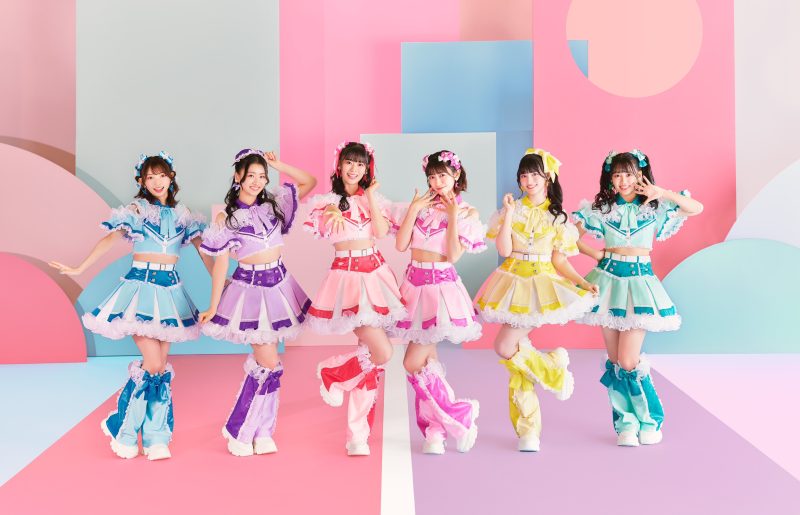
Featured: Cho Tokimeki♡Sendenbu
Seiyuus (声優, seiyuu): Voice actors – specifically, actors who voice characters in anime, video games, and drama CDs. Some seiyuus – especially seiyuus in popular series, seiyuus who perform in units, and young, attractive seiyuus – gain a dedicated fanbase and are treated similar to an idol. Due to the similarity of the industries, some seiyuus are marketed as idols, and some retired idols become seiyuus. Examples of seiyuus include Hina Suguta, Yui Ogura, and Nana Mizuki. Examples of seiyuu units include Aqours, Merm4id, and ST☆RISH.
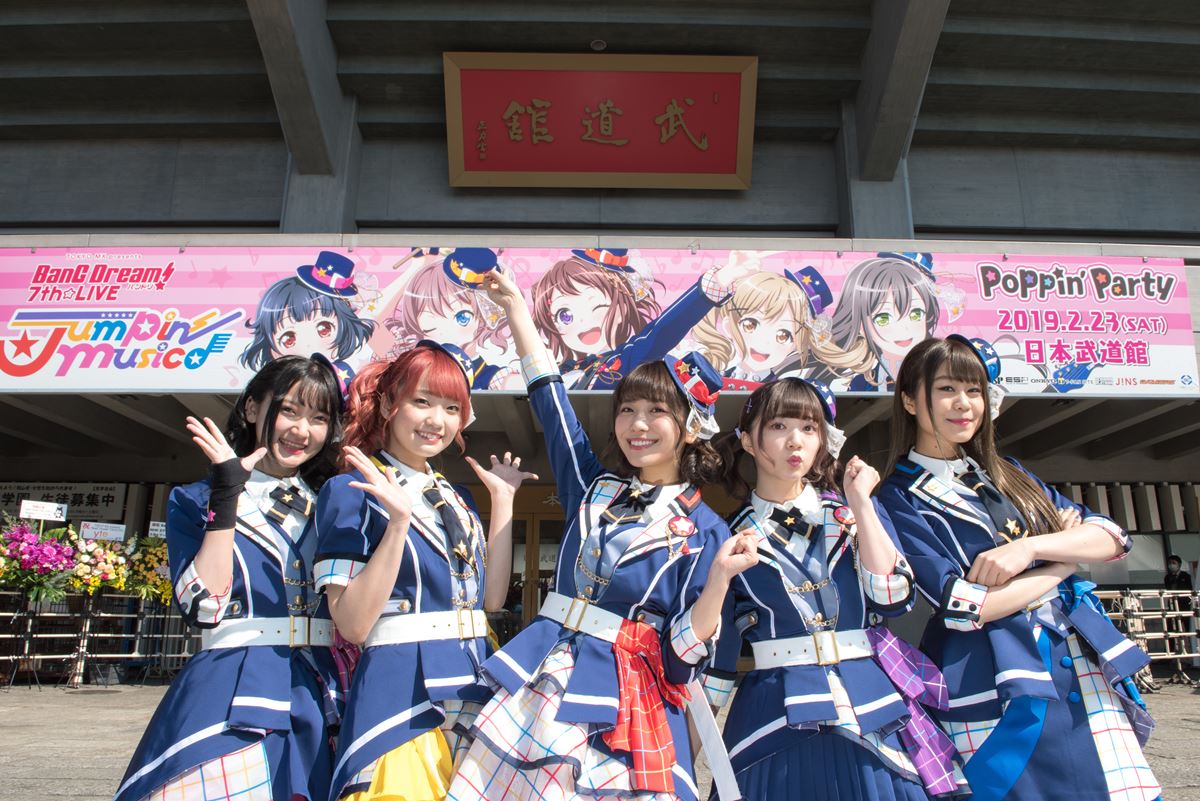
Featured: Seiyuu band Poppin’ Party in front of a poster of their characters.
Virtual Idols (バーチャルアイドル, bācharu aidoru): Fictional or partially fictional idols. Also called “kasō idols” (仮想アイドル), virtual reality idols/VR idols, and in some cases, CG idols (computer graphic idols). Ranges from fictional characters, such as Aya Maruyama from BanG Dream!, to VOCALOIDs or virtual singers such as Hatsune Miku, to VTubers such as Minato Aqua.
VTubers (ブイチューバー, buichūbā): Short for “virtual YouTuber” (バーチャルユーチューバー, bācharu yūchūbā). Streamers who use an animated avatar instead of their own face. VTubers, especially ones under agencies, are considered a type of virtual idol. Examples of popular Japanese VTubers are Kizuna AI, Inugami Korone, and Kuzuha. The industry has become internationally popular as well; examples of popular English-speaking VTubers include Gawr Gura, Mori Calliope, and Shxtou.
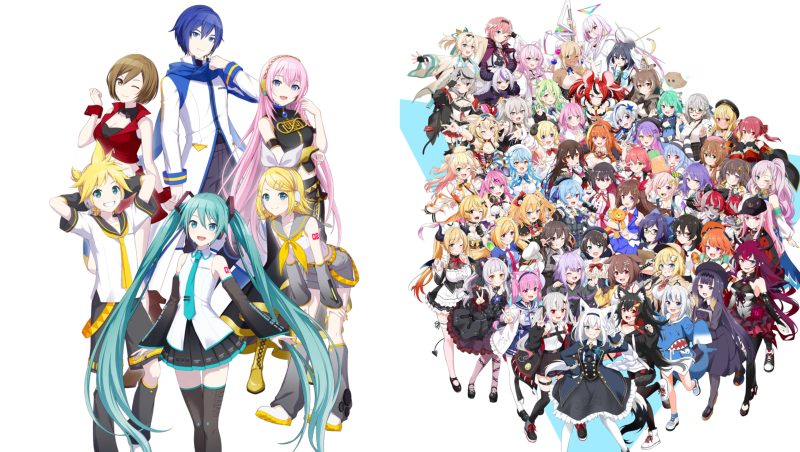
Left: Official art from Hatsune Miku: Colorful Stage! featuring virtual singers Hatsune Miku, Kagamine Rin and Len, Megurine Luka, MEIKO, and KAITO.
Right: All VTubers under hololive production as of December 2021.
Section 3 – Unique Genres:
 BABYMETAL is an international sensation credited with pioneering kawaii metal
BABYMETAL is an international sensation credited with pioneering kawaii metal
- Anison (アニソン): Short for “anime song” (アニメソング, anime songu). A genre consisting of music, typically pop, that is specifically created for anime, video games, drama CDs, and similar.
Notable Artists: Sumire Uesaka, Maaya Uchida, LiSA, Ichirou Mizuki, ClariS - Denpa Song (電波ソング, denpa songu): A category of music characterized by catchy and chaotic melodies, strange sound effects, high-pitched vocals, and nonsensical lyrics.
Notable Artists: Dempagumi.inc, Nanahira, Moso Calibration, Toromi, KOTOKO - City Pop (シティ・ポップ, shiti poppu): A genre of pop popular in Japan in the 70’s and 80’s. Definitions vary, but it is generally defined as as Western-inspired pop with influences of jazz, soft rock, R&B, disco, funk, and/or synth pop, or pop with an urban feel.
Notable Artists: Mariya Takeuchi, Anri, Omega Tribe, Junko Ohashi, Tatsuro Yamashita - Enka (演歌): Traditional Japanese ballads, or music inspired by traditional Japanese ballads.
Notable Artists: Keiko Fuji, Hachiro Kasuga, Shinichi Mori, Sayuri Ishikawa, Takashi Hosokawa - Idol Pop (アイドルポップ, aidoru poppu): Pop music performed by idols, especially female idols. Typically fun and upbeat with cute lyrics.
Notable Artists: AKB48, Morning Musume, Momoiro Clover Z, =LOVE, Girls² - Kawaii Metal (カワイイメタル, kawaii metaru): A fusion of J-Pop and heavy metal. Kawaii metal typically has the intense instrumentals of traditional heavy metal combined with cute lyrics and aesthetics.
Notable Artists: BABYMETAL, LADYBABY, Doll$Boxx, FRUITPOCHETTE, NECRONOMIDOL
Bonus: Kawaii Metal Groups To Listen To - Kayōkyoku (歌謡曲): Japanese pop music created during the Shōwa era (1929-1989) which became the basis for modern J-Pop. The characteristics of Kayōkyoku are a fusion of Japanese and Western music scales and simple melodies and lyrics.
Notable Artists: Momoe Yamaguchi, Seiko Matsuda, Kyu Sakamoto, Pink Lady, Akina Nakamori - Mixture Rock (ミクスチャー・ロック, mikusuchā rokku): A fusion of rock or metal and another genre such as rap, hip-hop, or reggae. Also known as alternative rock, funk rock, or rap rock.
Notable Artists: MAN WITH A MISSION, THE ORAL CIGARETTES, RIZE, Kuchiroro, Xmas Eileen - Shibuya-kei (渋谷系): A genre of pop that originated and peaked in Shibuya, Tokyo in the 90’s. Generally defined as J-Pop fused with genres like jazz, indie, house, downtempo, soul, and yé-yé. The resulting music has a futuristic and surrealist feel.
Notable Artists: Pizzicato Five, Flipper’s Guitar, Cornelius, Fantastic Plastic Machine, Mayumi Kojima - Visual Kei (ヴィジュアル系, vijuaru kei): A music and style movement intended to challenge conservative norms. Visual kei musicians are characterized by extravagant and androgynous costumes, heavy makeup, elaborate hairstyles, and shocking lyrics.
Notable Artists: X JAPAN, MALICE MIZER, Versailles, exist†trace, L’Arc〜en〜Ciel - Vocaloid (ボーカロイド, bōkaroido): Any music containing synthesized vocals or VOCALOIDs (see Section 1).
Notable Artists: wowaka, DECO*27, Mitchie M, Hachi, ryo
Section 4 – Notable Idols:
Johnnys

Johnnys (ジャニーズ, Janīzu): A boy group which debuted in 1962 and disbanded in 1967. They were first group produced by Johnny Kitagawa and Johnny & Associates (now known as SMILE-UP). Johnny & Associates has been a major figure in the idol scene since its founding and its influences are visible everywhere in the industry, such as in the trainee system used by both K-Pop and J-Pop agencies. Although the term “idol” wasn’t used for entertainers until after their debut, Johnnys is considered one of the first idol groups.
Onyanko Club
 Onyanko Club (おニャン子クラブ, Onyanko Kurabu): A girl group which debuted in 1985 and disbanded in 1987. Despite their brief career, they had 54 members, three sub-units, their own tv show and movie, and were incredibly popular to the point that the news of their disbandment was a massive shock. Their influence on the idol industry can still be seen today, especially in the popularity of school girl concepts, younger debut ages, the graduation system, and higher member counts.
Onyanko Club (おニャン子クラブ, Onyanko Kurabu): A girl group which debuted in 1985 and disbanded in 1987. Despite their brief career, they had 54 members, three sub-units, their own tv show and movie, and were incredibly popular to the point that the news of their disbandment was a massive shock. Their influence on the idol industry can still be seen today, especially in the popularity of school girl concepts, younger debut ages, the graduation system, and higher member counts.
SMAP
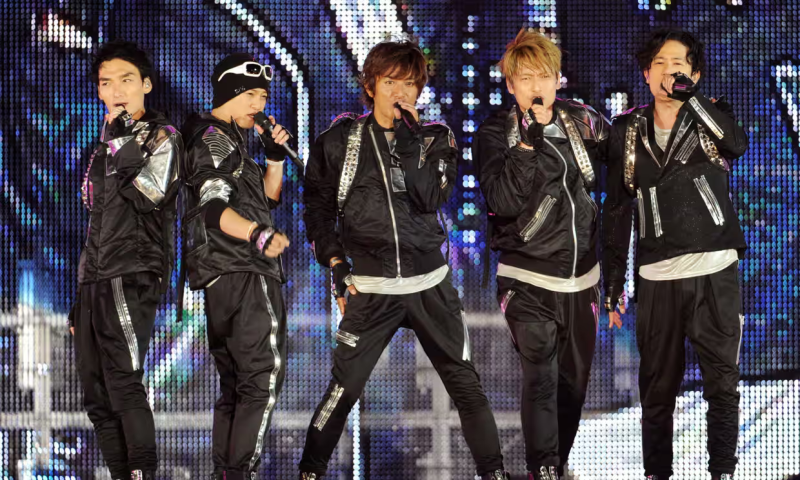 SMAP (スマップ, “Sports Music Assemble People”): A boy group which debuted in 1988 under SMILE-UP and disbanded in 2016. Described as “wildly beloved” by Billboard, the members’ personalities, versatility, and knack for entertainment, especially on variety shows, made them one of the most popular boy bands in Asia during their time. They ended their 28-year career as not only one of the most influential Johnny’s groups, but as one of the best-selling artists in Japan, one of the defining artists of the Heisei era, and as national icons.
SMAP (スマップ, “Sports Music Assemble People”): A boy group which debuted in 1988 under SMILE-UP and disbanded in 2016. Described as “wildly beloved” by Billboard, the members’ personalities, versatility, and knack for entertainment, especially on variety shows, made them one of the most popular boy bands in Asia during their time. They ended their 28-year career as not only one of the most influential Johnny’s groups, but as one of the best-selling artists in Japan, one of the defining artists of the Heisei era, and as national icons.
Morning Musume

Morning Musume (モーニング娘, Mōningu Musume): A girl group which formed in 1997 under Hello! Project and continues to this day as Japan’s longest lasting girl group. After the Idol Winter Period, Morning Musume helped renew public interest in idols. Their graduation system and dedicated fanbase has ensured their continued existence for 26 years after their debut, with a total of 47 members over 17 generations as of 2023. To this day, they are still one of the most successful and well-known Japanese girl groups and hold the record for Most Top 10 singles by an artist in Japan.
Arashi

Arashi (嵐): A boy group which debuted in 1999 under SMILE-UP. Despite being active for over 20 years, the members’ skills, personalities, and efforts to market outside of Japan has built them a steadfast fanbase and they remain one of the most popular Japanese boy groups of all time. During their career, they released 23 albums (9 of which are platinum), released more than 450 songs, earned 58 Japan Gold Disc awards, sold over 41 million records, and performed to over 14 million people. They hold the records for most number 1 singles by a Japanese artist and for the biggest-selling album worldwide in 2020 with 5×20 All The Best!!. The group is currently on hiatus since December 2020, but intend to resume activities in the future.
AKB48
 AKB48 (short for Akihabara48): A girl group which debuted in 2005 under DH and is known for their high member count. Their unique “idols you can meet” concept which includes daily live shows, frequent handshake events, and more interaction between fans and idols was a novelty at the time and made them a near-instant success. They have opened sister groups in Nagoya, Osaka, Fukuoka, Niigata, Okayama, Indonesia, China, Thailand, The Philippines, Taiwan, and more. To this day, they are one of the best-selling Japanese acts and the fifth best-selling girl group worldwide. Although their popularity has declined slightly in recent years, AKB48 remains the face of Japanese female idols.
AKB48 (short for Akihabara48): A girl group which debuted in 2005 under DH and is known for their high member count. Their unique “idols you can meet” concept which includes daily live shows, frequent handshake events, and more interaction between fans and idols was a novelty at the time and made them a near-instant success. They have opened sister groups in Nagoya, Osaka, Fukuoka, Niigata, Okayama, Indonesia, China, Thailand, The Philippines, Taiwan, and more. To this day, they are one of the best-selling Japanese acts and the fifth best-selling girl group worldwide. Although their popularity has declined slightly in recent years, AKB48 remains the face of Japanese female idols.
BABYMETAL
 BABYMETAL (ベビーメタル, Bebīmetaru): A girl group which debuted in 2010 under Amuse Inc. Originally a sub-unit of Sakura Gakuin, BABYMETAL distinguishes itself from its peers by performing heavy metal with influences of idol pop, also known as “kawaii metal.” Their uniqueness and individual talent has earned them fans worldwide, and while not as domestically popular as groups like AKB48 or Nogizaka46, they are one of the most internationally famous Japanese idol groups. They hold the record for the youngest act to perform at the Budokan (at the age range of 14-16), are the first Asian act to top the Billboard Rock Albums chart, and are the highest-charting Japanese band in UK chart history.
BABYMETAL (ベビーメタル, Bebīmetaru): A girl group which debuted in 2010 under Amuse Inc. Originally a sub-unit of Sakura Gakuin, BABYMETAL distinguishes itself from its peers by performing heavy metal with influences of idol pop, also known as “kawaii metal.” Their uniqueness and individual talent has earned them fans worldwide, and while not as domestically popular as groups like AKB48 or Nogizaka46, they are one of the most internationally famous Japanese idol groups. They hold the record for the youngest act to perform at the Budokan (at the age range of 14-16), are the first Asian act to top the Billboard Rock Albums chart, and are the highest-charting Japanese band in UK chart history.
JO1
 JO1 (ジェイオーワン, Jeiōwan): A boy group formed through Produce 101 Japan which debuted in 2020 under LAPONE Entertainment. They are a global boy group which fuses aspects of J-Pop and K-Pop to create their own unique sound, drawing in a large international fanbase alongside a domestic one. Despite being a relatively new group, they have earned instant popularity in the male idol scene and already have earned achievements such as three MTV Japan awards, two Billboard Japan awards, three MAMA awards, and more.
JO1 (ジェイオーワン, Jeiōwan): A boy group formed through Produce 101 Japan which debuted in 2020 under LAPONE Entertainment. They are a global boy group which fuses aspects of J-Pop and K-Pop to create their own unique sound, drawing in a large international fanbase alongside a domestic one. Despite being a relatively new group, they have earned instant popularity in the male idol scene and already have earned achievements such as three MTV Japan awards, two Billboard Japan awards, three MAMA awards, and more.
NiziU
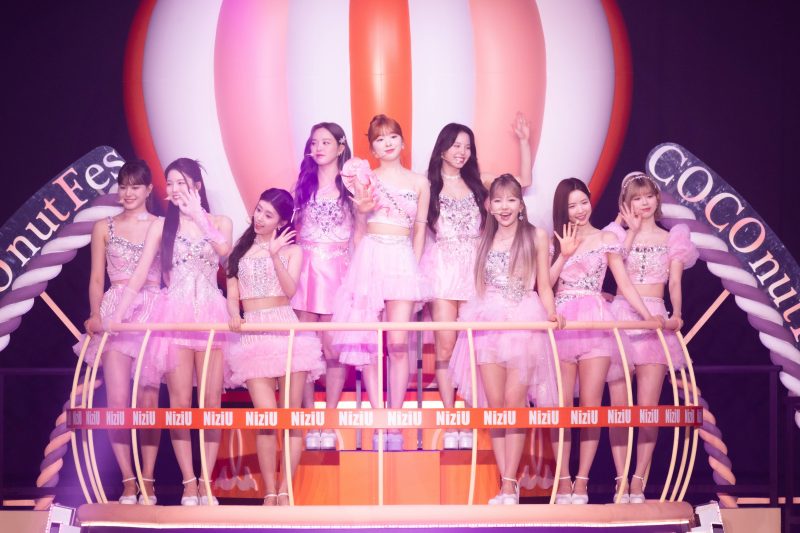 NiziU (ニジュー/니쥬): A girl group formed from Nizi Project which debuted in 2020. They are the first Japanese girl group produced by the infamous Korean company JYP Entertainment. NiziU stands out as a distinctive group by combining the best qualities of J-Pop idols and K-Pop idols, and their popularity has only expanded since their Korean debut in 2023. They are the fastest artist to appear on Kōhaku Uta Gassen after debut, consistenly top the charts and win awards, and their faces can be seen everywhere in Japanese advertisements.
NiziU (ニジュー/니쥬): A girl group formed from Nizi Project which debuted in 2020. They are the first Japanese girl group produced by the infamous Korean company JYP Entertainment. NiziU stands out as a distinctive group by combining the best qualities of J-Pop idols and K-Pop idols, and their popularity has only expanded since their Korean debut in 2023. They are the fastest artist to appear on Kōhaku Uta Gassen after debut, consistenly top the charts and win awards, and their faces can be seen everywhere in Japanese advertisements.
Section 5 – Notable Agencies:
 Featured: All active idol groups under SMILE-UP
Featured: All active idol groups under SMILE-UP
Japanese idols don’t have a “big three” agencies like South Korea, but these are some popular names you may encounter.
- SMILE-UP, Inc.
- Notes:
- Better known by it’s previous name – Johnny & Associates, Inc.
- Considered the first idol agency.
- Only produces male talents; temporarily held a monopoly on the male idol industry.
- Currently undergoing restructuring due to the founder’s (Johnny Kitagawa) convictions of sexual abuse.
- Notable Idols: Johnnys (Disbanded), King & Prince, Travis Japan, Snow Man, Arashi, SixTONES, Naniwa Danshi, Hey! Say! JUMP, SMAP (Disbanded).
- Notes:
- Stardust Promotion Co., Ltd.
- Note: Female idols are managed by STARDUST PLANET, and male idols are managed by EBiDAN.
- Notable Idols: Momoiro Clover Z, Shiritsu Ebisu Chuugaku, Cho Tokimeki♡Sendenbu, Bullet Train, BUDDiiS, DISH// (Disbanded).
- Amuse Inc.
- Notable Idols: Perfume, BABYMETAL, Sakura Gakuin (Disbanded), Karen Girl’s (Disbanded).
- UP-FRONT PROMOTION Co., Ltd.
- Notes:
- Is a sub-division of UP-FRONT GROUP Co., Ltd.
- Best known for Hello! Project, a collective of all of UP-FRONT PROMOTION’s female artists.
- Notable Idols: Morning Musume, ANGERME, Juice=Juice, BEYOOOOONDS, Tsubaki Factory, °C-ute (Disbanded), Mini-Moni (Disbanded).
- Notes:
- Yoshimoto Kogyo Holdings Co., Ltd.
- Note: Better known for managing comedians than idols.
- Notable Idols: NMB48, Yoshimotozaka46, OCTPATH, JO1, INI
- hololive production
- Note: Solely manages virtual idols, or VTubers.
- Notable Idols: Gawr Gura, Houshou Marine, Usada Pekora, Mori Calliope, Shirakami Fubuki, Hoshimachi Suisei, Kobo Kanaeru.
Section 6 – Music TV Programs:
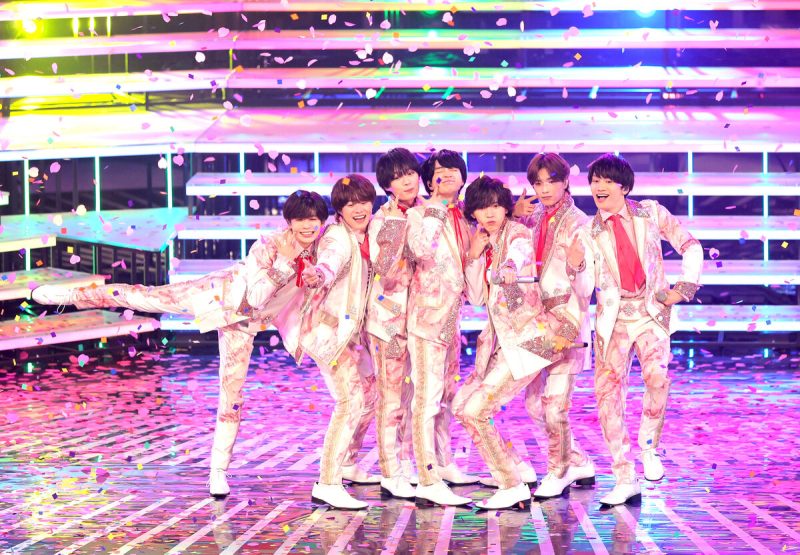
Featured: Naniwa Danshi performing at the 73rd Kōhaku Uta Gassen
- Kōhaku Uta Gassen (紅白歌合戦, Kōhaku Uta Gassen): Lit. “Red and White Song Battle.” A television special on NHK which airs annually on New Year’s Eve. The top artists in Japan and internationally are invited to attend, and are divided into the red group (female artists) and the white group (male artists). Winners are chosen by popular vote from both the audience and judges. Since only top artists are invited, being invited is a big deal for an artist’s career. Competitors in 2022’s episode include Perfume, Hinatazaka46, Nogizaka46, NiziU, Aimer, SEKAI NO OWARI, milet, IVE, LE SSERAFIM, TWICE, SixTONES, Naniwa Danshi, JO1, BE:FIRST, Snow Man, King & Prince, Kanjani Eight, KinKi Kids, and more.
YouTube Channel: NHK MUSIC - MUSIC STATION (ミュージックステーション, Myūjikku Sutēshon): A music variety show on TV Asashi which airs weekly on Fridays. It is hosted by comedian Tamori and announcer Marina Namiki. 5-8 artists perform per show.
YouTube Channel: MUSIC STATION - COUNT DOWN TV (カウントダウン・ティーヴィー, Kauntodaun Tīvī): Also called CDTV. A music ranking show on Tokyo Broadcasting System which airs weekly on Mondays. It shows live performances and lists the top songs and artists of the week.
YouTube: CDTV 公式YouTube - MelodiX! Premium (プレミアMelodiX!, Puremia MelodiX!): A music program on TV Tokyo which airs weekly on Tuesdays. Primarily features live performances. Hosted by the comedy duo Nankai Candies.
- SHIONOGI MUSIC FAIR (シオノギ・ミュージックフェア, Shionogi Myūjikku Fea): A music program on Fuji Television which airs weekly on Saturdays. It is Japan’s longest running music show, having run since August 31, 1964.
Section 7 – Other:
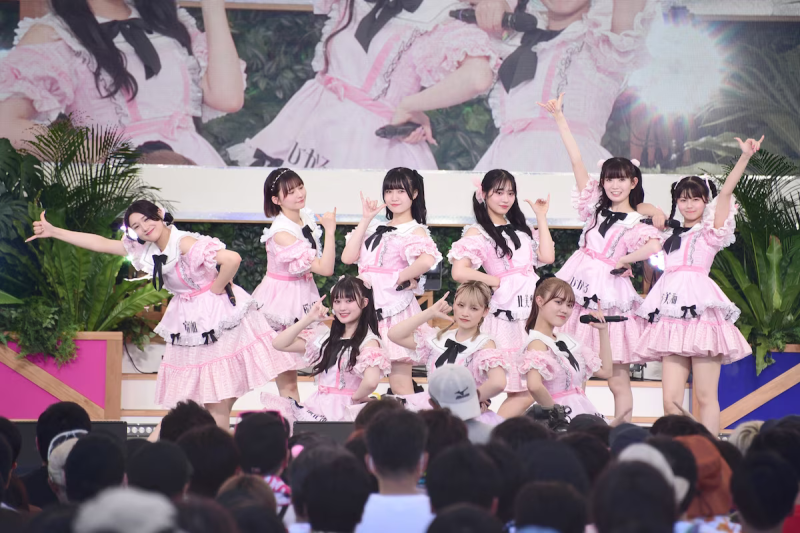 Featured: Iginari Tohoku San at TOKYO IDOL FESTIVAL 2023
Featured: Iginari Tohoku San at TOKYO IDOL FESTIVAL 2023
- Nippon Budokan (日本武道館): lit. “Japan Martial Arts Hall,” often shortened to Budokan (武道館). One of the largest and most famous concert venues in Japan. It is located in Chiyoda, Tokyo and primarily serves as an arena for martial arts. Many music artists, especially idols, have performing at the Budokan as their ultimate goal.
- Tokyo Dome (東京ドーム, Tōkyō Dōmu): A major music venue in Bunkyo, Japan. Primarily serves as a baseball stadium and occasionally hosts tournaments for other sports. Artists all around the world perform there, but three idol groups (KinKi Kids, Arashi, and Kanjani Eight) hold the records for most solo performances.
Bonus: K-Pop Groups That Have Performed at Tokyo Dome - Tokyo Idol Festival (トウキョウ・アイドル・フェスティバル, Tokyo Aidoru Fesutibaru): Often shortened to “TIF.” An annual music festival held in Odaiba, Tokyo which primarily features female idol groups. It is the largest idol festival in Japan, featuring around 200-300 artists. All kinds of idols – big names, underground groups, alternative idols, orthodox idols, junior idols, gravure idols, bandols, soloists, and everything in between – perform there. The event was started by idol and producer Rino Sashihara in 2010 and has been thriving ever since.
- SUMMER SONIC (サマーソニック, Samā Sonikku): An internationally renowned music festival held annually in Chiba and Osaka, Japan. It features both international and domestic artists.
- Golden Age of Idols (アイドル黄金時代, Aidoru Ougon Jidai): The 1980’s; this was the era when there was a surge of new idols and idol groups debuting and a growing commercial interest in idols. Idols began appearing more frequently on variety shows, commercials, and music shows. The most influential idols of this era include Seiko Matsuda, Akina Nakamori, and Onyanko Club.
- Idol Winter Period (アイドル冬の時代, Aidoru Fuyu no Jidai): A period from the late 1980’s to the late 1990’s. Began shortly after Onyanko Club‘s disbandment in 1987. Slowly, idols stopped being featured in TV shows, commercials, and magazines and few groups debuted; many groups which did disliked the idol label. Morning Musume‘s success helped contribute to the end of this era.
- Idol Warring Period (アイドル戦国時代, Aidoru Sengoku Jidai): A period that began in 2010 with a boom of new idol groups and idols rising to popularity. As more groups debuted, they experimented with more concepts and the idol scene diversified, drawing in new fans, and idol groups began setting new records for musicians in Japan. Tokyo Idol Festival was established the same year. There is no set date for when this era ended, but 2019 can be considered the final year of the warring period as it was the last year before the pandemic (which had a strong impact on the idol industry) and the final year of the Heisei era.
Related:
Ultimate K-Pop Vocab Guide
Ultimate K-Pop Vocab Guide Part Two
What is a Kaigai Idol?: An Introduction and Guide to the Overseas J-Pop Community
Made by fairymetal
Was this guide helpful? Is anything missing? Feel free to comment down below.



